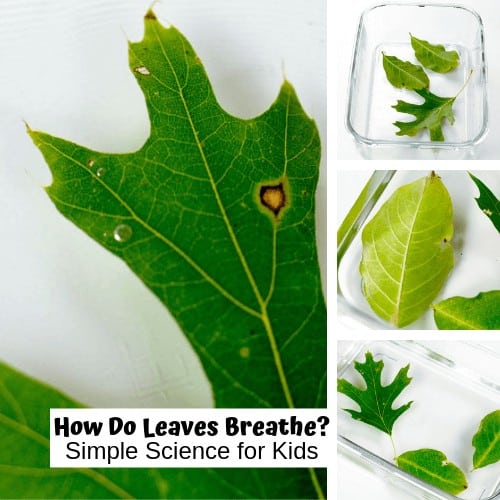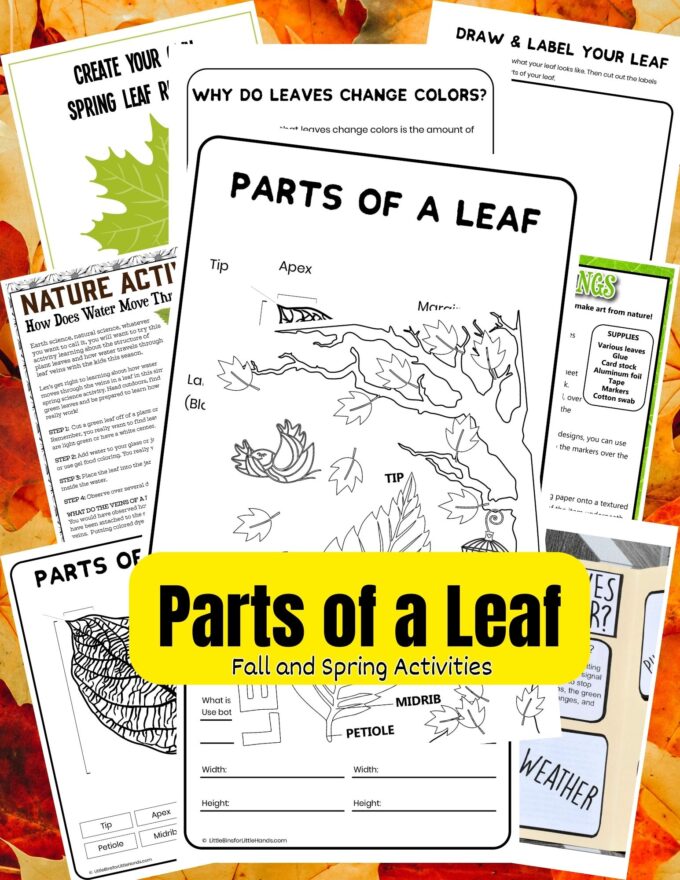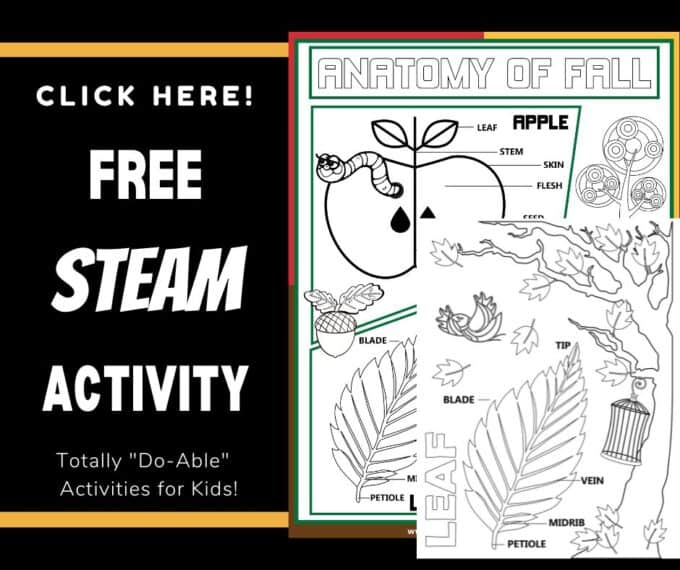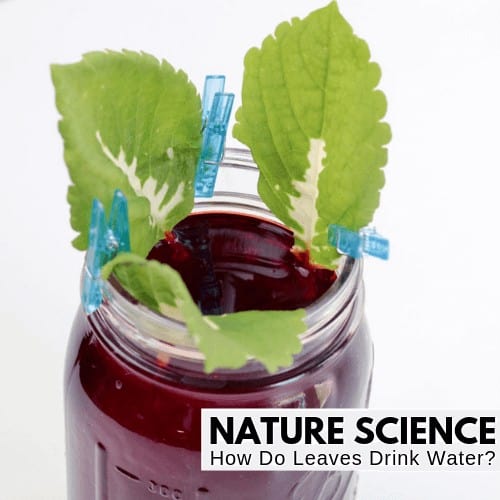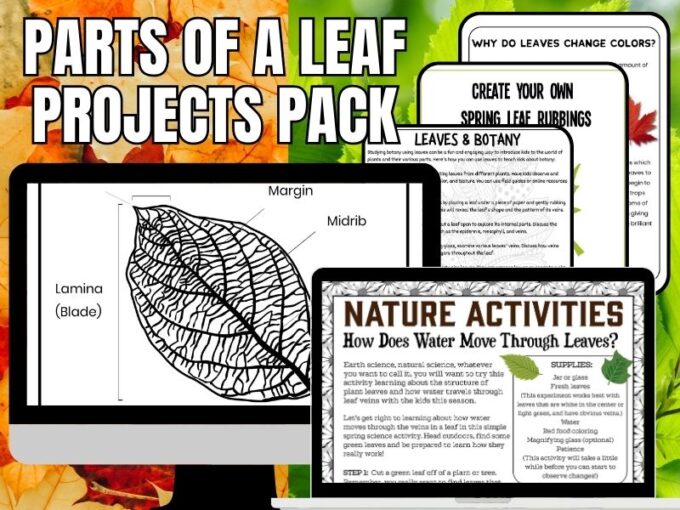Learn about the parts of a leaf, their functions, and discover some fantastic leaf activities with this fun printable leaf worksheet and coloring page! Learn a bit about botany and leaves with a fun science project you can use both in the fall and spring! Find out what are the 5 different leaf parts and their functions. Pair it with these other fall science activities too!
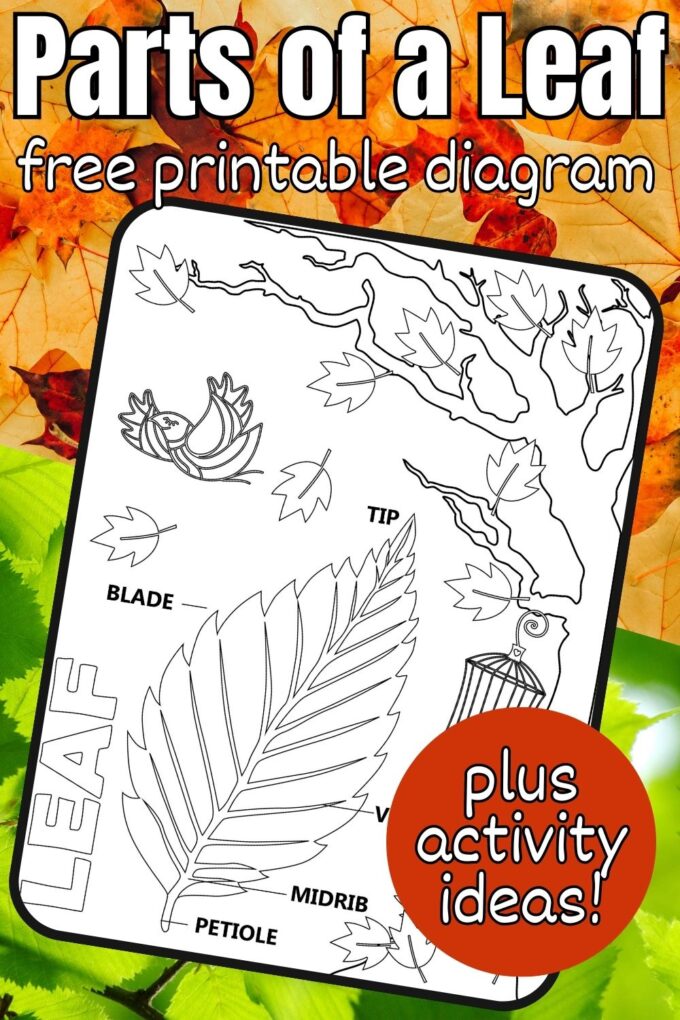
Botany and Parts of a Leaves
Studying botany involves exploring the secrets of plants, and understanding the parts of a leaf is a fantastic way to start. Imagine you’re a plant detective!
Botany helps kids solve mysteries about leaves. You learn about the leaf’s blade, which catches sunlight like a solar panel, and the veins, like tiny roads that carry water and food. The stem is like the leaf’s strong arm holding it up, and the petiole is its unique handle. The midrib is like a leaf’s backbone, helping everything stay connected.
Combining these parts, you unlock the leaf’s secrets: how it takes in sunlight, drinks water, and makes food. Botany lets you explore and discover how plants grow and thrive in the plant world.
Explore Leaf Parts For Fall or Spring
Leaves are fun to incorporate into science and art lessons each fall (or spring), or any time of the year. Learning with leaves can be hands-on, and kids love it! There are so many different types of leaves found in nature, and different shapes too!
You can do all kinds of projects involving leaves, and each year we have a hard time choosing because we want to do them all!
We enjoy doing these leaf art and crafts, learning about why leaves change color in the fall, and setting up simple experiments to investigate how water travels through leaves and how plants breath through their leaves.
Parts Of A Leaf and Their Functions
leaves are like nature’s solar panels. They use the sun’s energy, water, and air to make food for the plant. Learning about these parts can help you understand how leaves and plants work together to grow and stay healthy!
Check out the complete Plants, Leaves, and Seeds Project Pack for a more in-depth study.
What are the 5 parts of a leaf?
Petiole
A stalk that attaches the leaf to the stem of the plant. It can be long, think about celery and rhubarb, or short. On some leaves, there may be no petiole.
Midrib
The thick, central vein runs down the middle of the leaf. If you turn a leaf over, you can sometimes feel the midrib vein because it sticks out. The midrib supports the leaf and transports nutrients and water to the different areas of the leaf through other veins.
Veins
The lines or patterns you can see on the surface of a leaf. Leaf veins are made up of two types of continuous long thin tubes. They help water and food travel around the leaf so it can stay healthy.
The xylem transports water from the plant’s roots to the leaves via capillary action. Phloem takes the food made in the leaves via photosynthesis to the rest of the plant.
Blade
The central part of the leaf. It can be broad and flat or long and narrow like grass.
Tip
The endpoint of the leaf blade.
Also Explore: Why Do Leaves Change Color
Free printable parts of a leaf labeled diagram and worksheet!
Use our printable labeled leaf diagram (free download below) to learn the basic leaf parts. Students can see the different parts of a leaf, discuss what each part does, and then color the leaves in.
Parts Of A Leaf Activities
Extend the learning by going outside and collecting various types of leaves. For kids, understanding the different parts of leaves and learning about botany go hand in hand because botany is the science that helps us understand and study plants, including their different parts and how they function.
- Can you identify the different parts of the leaf described above?
- How are they similar or different to each other?
- Why do you think that might be?
- Draw a picture of your leaf, and label the parts.
Leaves and Botany
Studying botany using leaves can be a fun and engaging way to introduce kids to the world of plants and their various parts. Here’s how you can use leaves to teach kids about botany:
Identification: Start by collecting leaves from different plants. Have kids observe and compare the leaves’ size, shape, color, and texture. You can use field guides or online resources to help identify the plants.
Try this book: Trees, Leaves, Flowers and Seeds: A Visual Encyclopedia of the Plant Kingdom (DK Our World in Pictures) – Amazon Affiliate link.
Rubbings: Create leaf rubbings by placing a leaf under a piece of paper and gently rubbing it over it with crayons or pencils. This will reveal the leaf’s shape and the pattern of its veins. Or try this Leaf Rubbing STEAM activity.
Dissection: Select and gently cut a leaf open to explore its internal parts. Discuss the layers and structures they see, such as the epidermis, mesophyll, and veins.
Vein Exploration: Using a magnifying glass, examine various leaves’ veins. Discuss how veins transport water, nutrients, and sugars throughout the leaf. Try this leaf veins experiment.
Journal: Create a leaf journal where kids can glue leaves onto pages and write observations about each leaf. This can include details about the plant it came from, its size, color, and any unique features.
Prints and Art Projects: Apply paint to the surface of a leaf and press it onto paper to create leaf prints. This activity can showcase the intricate details of a leaf’s texture. Try these leaf art projects.
Sorting: Gather various leaves and have kids sort them based on different characteristics, such as size, shape, or margin type. This helps them notice differences and similarities.
Puzzle: Cut out different parts of leaves (blade, petiole, midrib, etc.) from paper. Have kids assemble the parts like a puzzle to build a complete leaf.
Nature Scavenger Hunt: Organize a scavenger hunt where kids search for leaves with specific characteristics, such as a particular shape, color, or size.
By incorporating these hands-on activities, kids can explore and understand the fascinating world of plants and their leaves while having a great time learning about botany.
Try this Leaf Rubbing for a fantastic fall or spring STEAM activity.
Different Shapes of Leaves
Here are some of the most commonly found shapes of leaves with examples that kids can search for on an outdoor nature hunt:
Tip: If you can’t find many of these shapes outdoors, do a safe internet search or head to the library and make sure to look for each one!
- Heart-Shaped: Look for leaves shaped like hearts, like those of the Sweetheart Hoya plant or the Redbud tree.
- Oval: Find leaves that look like stretched-out circles, such as leaves from the Maple tree or the Lilac bush.
- Round: Seek out perfectly round leaves, like those of the Pennywort plant or the Water Lily.
- Spear-Shaped: Search for long and pointy leaves resembling tiny spears. Leaves from the Iris plant or the Corn plant might be good examples.
- Serrated (Sawtooth): Look for leaves with edges that have small, jagged teeth. You might find these on the Blackberry bush or the Oak tree.
- Lobed: Find leaves that have rounded sections taken out, like puzzle pieces. Oak tree leaves or those from the Tulip Poplar tree are good examples.
- Compound: Look for leaves like a bunch of smaller leaves attached to one stem. Clover leaves, or leaves from the Mimosa tree, are compound.
- Palmate (Hand-Shaped): Look for leaves that spread out like fingers from a central point, resembling a hand. Leaves from the Maple tree or the Horse Chestnut tree are palmate.
More Leaf and Plant Activities For Kids
Looking for more plant lesson plans? Here are a few suggestions for fun plant activities that would be perfect for preschoolers and easy plant experiments for elementary and middle school.
Learn about the apple life cycle with these fun printable activity sheets!
Use art and craft supplies to learn about the different parts of a plant and the function of each.
Use a few simple supplies you have on hand to grow these cute grass heads in a cup.
Grab some leaves and find out how plants breath.
Learn about how water moves through the veins in a leaf.
Watching flowers grow is an amazing science lesson for kids of all ages. Find out what are easy flowers to grow!
See up close how a seed grows with a seed germination jar.
Printable Parts of a Leaf Pack
Explore 30+ activities for various skill levels for plants, leaves, and seeds! Perfect for Kindergarten through Elementary school grades (or whatever skill level suits your needs). Activities are easily used for both fall and spring science lessons.
Whether in the classroom or at home, all activities are doable and engaging, with plenty of science information to support your lessons! All activities use budget-friendly supplies.
What’s Included:
- Hands-on Activities with instructions, templates, and images
- Worksheets for labeling, identifying, and matching seeds, leaves, and plants
- Vocabulary Words
- Crossword Puzzle (to test knowledge)
- Why Leaves Change Colors and Lapbook
- All about Leaves Pack
- All About Seeds Pack
- Learn About Photosynthesis
- And More!


